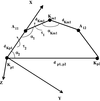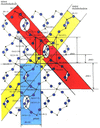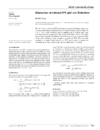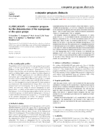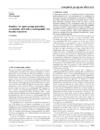issue contents
August 2002 issue

Cover illustration: The crystal structure of titanite, CaTiOSiO4, viewed down the direction of the octahedral TiO6 chains. The full green lines indicate a unit cell of the two-dimensional Ising model, used to predict diffuse scattering intensity observable in layers normal to the chain direction. Ti atoms are shown in green, Ca in light grey, O in blue. The thinner red lines are Si-O bonds, the thick red lines Ti-O1 bonds. Courtesy of T. Malcherek, C. Paulmann, M. C. Domeneghetti & U. Bismayer [J. Appl. Cryst. (2001), 34, 108-113].
research papers
Free 

This second part of a round robin on the determination of quantitative phase abundance from diffraction data addresses problems including preferred orientation, the analysis of amorphous content, microabsorption, complex synthetic and natural mineral suites, along with pharmaceutical mixtures with and without an amorphous component. It is concluded that the greatest physical obstacle to accurate quantitative phase analysis for X-ray based methods is the presence of absorption contrast between phases (microabsorption), which may prove to be insurmountable in some circumstances.
The paper describes a method based on orientation distances for evaluating the orientation of a parent b.c.c. (body-centred cubic) grain from several h.c.p. (hexagonal close packed) inherited variants in the case of an approximate (b.c.c.–h.c.p.) orientation relation.
IsGISAXS: a program for grazing-incidence small-angle X-ray scattering analysis of supported islands
The purpose of the IsGISAXS program is to simulate and analyse grazing-incidence small-angle X-ray scattering of islands on a substrate in the distorted-wave Born approximation. Various island shapes and repartitions on the substrate are encompassed in the program.
A new method able to locate cations and surrounding anions in tetrahedral or octahedral coordination is described.
The internal reflection of an excited X-ray waveguide mode at an internal lateral boundary in a synthetic nanostructure has been measured. The experiment constitutes an important step towards the production of a coherent nanometre-sized X-ray point source by two-dimensionally defined waveguide structures.
Extended X-ray absorption fine structure (EXAFS) and neutron scattering data from monoclinic zirconia are analysed independently and simultaneously by reverse Monte Carlo (RMC) modelling; analysis of EXAFS spectra by RMC modelling results in reliable and accurate information on the local structure consistent with neutron scattering and X-ray diffraction experiments. A simultaneous analysis of neutron scattering and EXAFS data provides more complete information on the local structure than the analysis of the independent data sets.
Download citation


Download citation


Factors influencing the performance of a simulated-annealing approach to the determination of molecular crystal structures from X-ray powder diffraction data are investigated.
A special kind of triangular dendrite of LiAlSiO4–SiO2 (or Li1−xAl1−xSi1+xO4, 0 ≤ x ≤ 1) in matt glaze has been observed by DIC (differential interference contrast) microscopy.
Metal-organic networks formed by crosslinking aluminium-organic-stabilized platinum nanoparticles with bifunctional spacer molecules are investigated by anomalous small-angle X-ray scattering. For the structural characterization, a model function for a multicomponent system of hard spheres is proposed and applied to three different samples; the results are compared with those obtained from X-ray absorption measurements and the application of Fourier methods (characteristic function).
The use of pixel detectors at synchrotron beams is described.
Theoretical and practical aspects of handling atomic anisotropic displacement parameters are discussed.
A method is described to combine the Rietveld and the whole-pattern decomposition techniques for the quantitative phase analysis of mixtures containing phases with unknown or imperfectly known crystal structure.
Computation of attachment energies, which are considered to be directly related to the growth rates of the corresponding F faces, has been performed using an electrostatic point-charge model, taking into account Born repulsion and van der Waals contributions computed by means of the Gilbert equation or the van Beest and van Santen short-range potentials.
The Bragg edges appearing in time-of-flight neutron transmission experiments are used in combination with the sin2ψ technique to map the spatial variation of the unstressed lattice parameter in a ferritic weld. The technique is first introduced and then validated on a specially prepared biaxially stressed sample before use on a ferritic steel weld.
short communications
The fast Fourier transform (FFT) algorithm as normally formulated allows one to compute the Fourier transform of up to N complex structure factors, F(h), N/2 ≥ h > −N/2, if the transform ρ(r) is computed on an N-point grid. This note calls attention to a simple remedy whereby an FFT can be used to compute the transform on as coarse a grid as one desires without loss of precision.
Neutron diffraction data have, for the first time, been recorded from collagen in cancellous human bone.
laboratory notes
A modular protein crystallization plate is described.
computer program abstracts
A computer program for the determination of supergroups of space groups is described.
A system of computer routines for a space-group symmetry, for automatic generation of the asymmetric unit and for crystallographic FFT was developed. These routines can be helpful in solving various crystallographic problems.


 journal menu
journal menu












